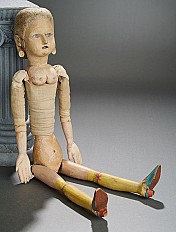- Estimate
- $22,000 / $29,000

Stuart's Take
I recently watched the movie, Napoleon, and was intrigued by Napoleon's rise during the pre and post revolution period. A time which the movie presented as a period of satire, especially of anyone who surrounded Marie Antoinette or the aristocracy of that time. Theater was ripe with these satires, as if people were hungry for comedy. One might say we do the same today? The difference being that back then they used dolls and actors as a form of media.
This, a portrait of Marie Thérèse Louise, The Princess of Lamballe, is a remarkable example of the satire that would explode in France during this period of the late 1700's. And her history was certainly as intriguing as the doll itself.
She became part of Marie Antoinette's court and unarguably her closest confidante. So close that rumors flourished throughout France that she was Marie's lover behind closed doors, often announced by the opposition as an attempt to disparage her. Over time, these rumors would result in the Princess to be cast away from Antoinette's court. Alas, she would return at the end of Marie's reign as a display of love and loyalty during her downfall. In the end she become a beloved, though controversial, figure in France given this loyalty.
Her final words when being questioned before her execution,"Who are you?"
"Marie Thérèse Louise, Princess of Savoy."
"Your employment?"
"Superintendent of the Household to the Queen."
"Had you any knowledge of the plots of the court on the 10th August?'"
"I know not whether there were any plots on the 10th August; but I know that I had no knowledge of them."
"Swear to Liberty and Equality, and hatred of the King and Queen."
"Readily to the former; but I cannot to the latter: it is not in my heart."
[Reportedly, agents of her father-in-law whispered to her to swear the oath to save her life, upon which she added:]
"I have nothing more to say; it is indifferent to me if I die a little earlier or later; I have made the sacrifice of my life."
"Let Madame be set at liberty."
Much of the research of these dolls, which should be considered some of the most important ever made in doll history, was done by Francois Theimer, who, literally, wrote the book on French Court Dolls. This particular example was featured in his work in an entire chapter, laying out the Princess of Lamballe's unique place in French culture and as to the artistry and detail of the doll we see here.
Truly, a fantastic piece of cultural and artistic importance. An embodiment of my belief that stories are at the root of any object.




